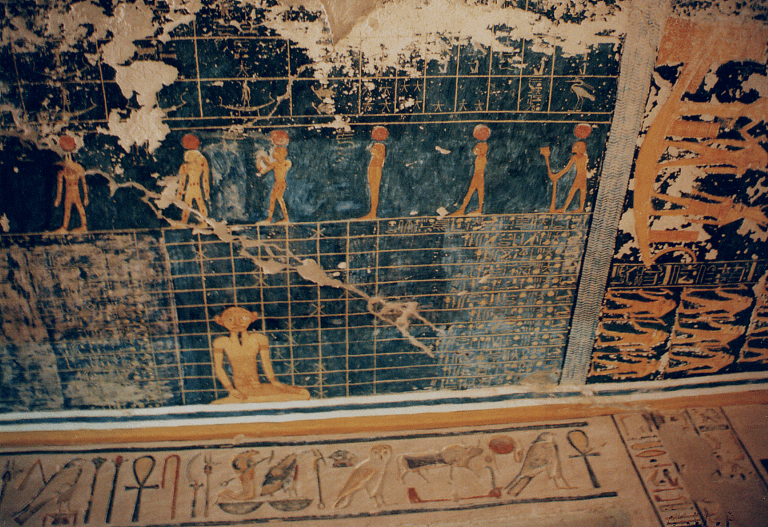Dr. Sarah Symons’ research profiled at the Perimeter Institute

Featured image: Part of a Ramesside star clock on the ceiling of tomb KV6 in the Valley of the Kings, Egypt. This is the tomb of pharaoh Ramses IX, c. 1131-1112 BCE during Egypt’s New Kingdom. Image Credit: Sarah Symons.
Read full story originally published by the Perimeter Institute in Waterloo
Luna Zagorac’s day job as a postdoctoral fellow at the Perimeter Institute for Theoretical Physics concerns the search for dark matter. But some days, she can be found poring over ancient hieroglyphic inscriptions from pharaohs’ tombs that document the movement of the stars.
“The sky looked very different 1,000 years ago, and 1,000 years before that, because stars in the sky move. That’s one of the things we wrestle with when trying to compare to data from long ago,” she says. The challenges are worth it: these 3,000-year-old texts show a surprisingly modern grasp of astronomy and timekeeping.
Zagorac has teamed up with two experts in the history of science, Sarah Symons of McMaster University and Petra Schmidl of the University of Erlangen-Nuremberg. Together, they’re hoping to interpret some of the earliest astronomical datasets ever recorded.
They’re called the ‘Ramesside star clocks,’ and there are four of them, dating from the 12th century BCE. While some older star clocks exist, none are so carefully systematic as these. Each consists of 24 tables that track the movement of the stars across the night sky.
Individually, each table features the name of a star, shows its position at each hour of the night, and covers a 15-day period. The 24 tables together chart an entire year.
Archeologists discovered the clocks painted on the ceilings of pharaohs’ tombs.
“Egyptian temples and tombs are a little bit like model universes. The ceiling or the inside sarcophagus lid represented the sky of that little universe,” says Symons. “In this case, it’s not a map that’s stationary, because it has a time aspect: it’s actually a moving map of the sky. You could say that these tables create a sort of planetarium in a tomb.”
Archeologists have a pretty good grasp of the symbolic and ritual nature of the star clocks. They formed part of the ‘machine’ of royal tombs that transported pharaohs to the afterlife. Furthermore, the clocks probably served a purpose beyond the domain of the dead – the original versions of the clocks were likely created on papyrus in temple libraries, used by priests whose duties included a timekeeping function.
Interpreting the star clocks gets difficult, however, when relating them to the real-life night sky.
In the tombs, each star table is depicted adjacent to a seated human figure, and the star positions are described in relation to a body part: the heart, eyes, ears, or shoulders. Evidently, astronomical observations were carried out by measuring a star’s position with respect to a figure, but there are no instructions as to where the figure itself should be positioned.
Was it the observer’s own reflection in a pool, with the night sky behind? Was it a statue of a figure, set high against the horizon? Or maybe there was a specific rooftop corner of a specific temple, with a seat dedicated to nightly timekeeping observations.
Archeologists don’t know. They have the star charts, but not the instruction manual.
Luckily, some of the stars are identifiable: the constellation Sahu, in ancient Egypt, maps closely to the modern Orion, while Sopdet is the bright star Sirius. Both inhabit the southern skies. The situation is complicated, however, because stars from the northern sky are also represented. The star clocks refer, for example, to a constellation called the Mooring Post – the fixed point in the northern sky around which all other stars rotate.
Read more at Perimeter Institure.
UncategorizedRelated News
News Listing

December 6, 2024
Generative Artificial Intelligence in Life Science and History Courses: Experiences, Opinions, and Policy Implementations
Uncategorized
October 24, 2024

Not the usual lesson in chemistry – assistant prof turns labs into an escape room for next gen scientists
Uncategorized
August 6, 2024
